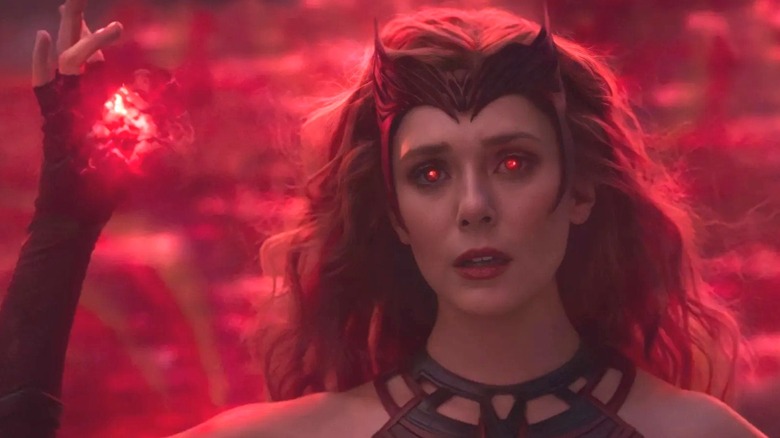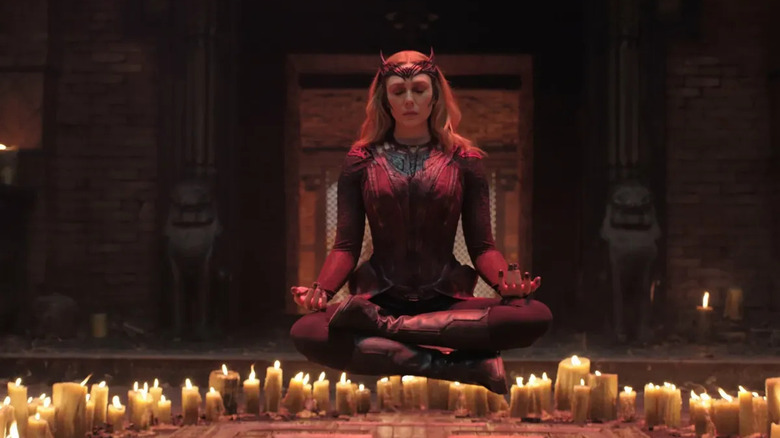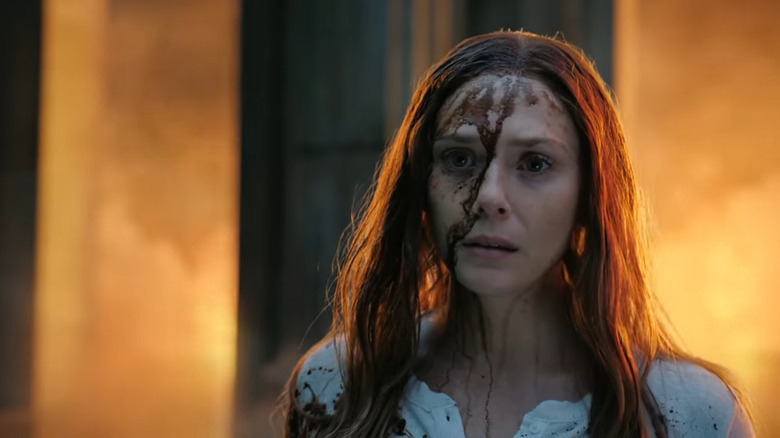Elizabeth Olsen Says The Doctor Strange 2 Writers Hadn't Seen WandaVision
There are many small, frustrating things about Sam Raimi's 2022 superhero flick "Doctor Strange in the Multiverse of Madness."
A notable example: Because he's desperate and uncreative, Doctor Strange (Benedict Cumberbatch) uses a cursed spell book, the Darkhold, to make himself more powerful and save the day. But he didn't fully comprehend the power of the Darkhold's wickedness, and the final shot of the film is of Doctor Strange wailing in terror as he realizes he has become corrupted by demonic forces. A third eye opens on his forehead. Is he evil now? As it turns out, no, as the film's post-credits stinger depicts Doctor Strange walking down the street, totally at ease with his corruption. The consequences were immediately erased.
A more notable example of the frustrations in "Multiverse of Madness" is the treatment of the film's villain, the Scarlet Witch (Elizabeth Olsen). The character, also known as Wanda, had just left the events of the TV series "WandaVision," having come to a profound catharsis about herself. In the series, Wanda was mourning the death of Vision (Paul Bettany), an android with whom she had fallen in love. In order to eschew the pain, she unwittingly enslaved a small suburban town and forced them to live in a sitcom-like fantasy world with her. She had two children in her fantasy. At the end of the series, Wanda realized that what she did was unethical, and flew away to wrestle with that notion.
But at the beginning of "Multiverse," thanks to the effects of the Darkhold, Wanda is merely evil. Her catharsis, it seems, didn't mean much.
In a recent video interview with Vanity Fair, Olsen pointed out the reason why her character transformed so dramatically. It seems that Michael Waldron, the "Multiverse" screenwriter, hadn't seen "WandaVision."
She's just evil now
In the interview, Olsen — with a few years distance — seems a little perplexed by the vast and complex mythology of the Marvel Cinematic Universe. Hearing herself saying lines like "You, Vision, are the piece of the Mind Stone that lives in me" in "WandaVision" struck her as particularly absurd. "That's some crazy s*** to say!" she laughed, saying it was like speaking in a foreign language and she essentially had to "translate" the lines into something emotionally resonant for the scene. On the page, it seems, the scene didn't make a whole lot of sense.
It became especially confusing when Olsen realized that her character was given the same arc in "Multiverse of Madness" as she was in "WandaVision." Both were about coping with grief, although weirdly, it was two renditions of grief stemming from the exact same event. Although the MCU tends to get credit for its broad, interlocking stories, it seems that clear communication wasn't always of paramount importance between respective screenwriters. When Olsen clocked the similarities between her series and her new movie — with the character tragic in one and merely villainous in the other — she mentioned it to the screenwriters. It seems they were clueless. She said:
"It's a similar arc in 'Multiverse of Madness' that it is in 'WandaVision.' There could be parallel stories being told there of dealing with grief and loss. Well, I proposed that to the writers of 'Multiverse.' I said 'Do you know what we're doing in 'WandaVision'? Have you seen it?' And, no, they had not seen it because it wasn't finished yet."
It was a clear moment when the MCU tripped over its own feet. This was not the well-oiled machine the first 20-odd movies made us believe.
Making it interesting
In a position where she had to more or less enact the same story twice, Olsen decided to make things interesting for herself as an actress. Rather than merely play the exact same emotional beats as she just had in "WandaVision," she made her character scarier and darker. This was partly to stave off boredom, but also to assure anyone who had watched "WandaVision" that "Multiverse of Madness" was a different animal. When it came to the larger arc of the character, "Multiverse" didn't make sense, but at the very least the two MCU chapters had a great deal of visual variety.
"So I had to try and, I don't know, play it differently, right? I had to attack the same themes — in order for it to be interesting for me, I think, and potentially for the audience — I just had to come out from a different point of view so that it wasn't repetitive."
Besides, who's to say that the Wanda in "Multiverse" was the same one from "WandaVision?" Thanks to the "parallel universes" plot that the MCU is currently embroiled in, any character could be an alternate version of themselves at any time. Characters can die, only to be rescued from another timeline, and wild character shifts can be explained away with a wave of the wand. The multiverse was an organic way to include characters from disparate film franchises together in the same scene (see: the Illuminati from "Multiverse" or the raison d'être of "Spider-Man: No Way Home"). The only major consequence of employing it as a story device is that, well, consistency and death no longer need to be permanent or even taken seriously.


